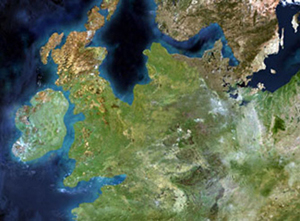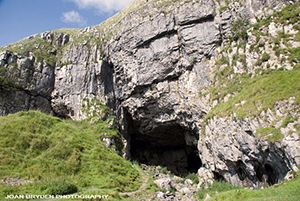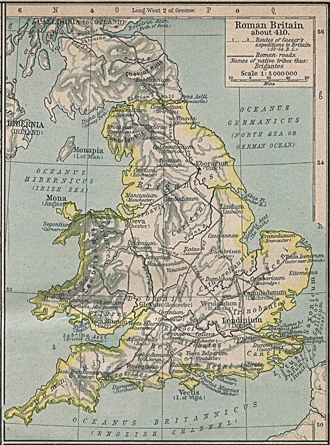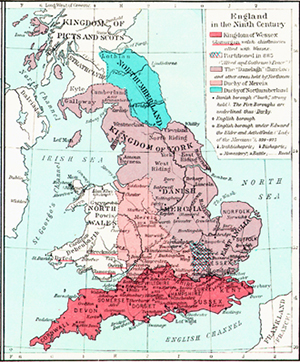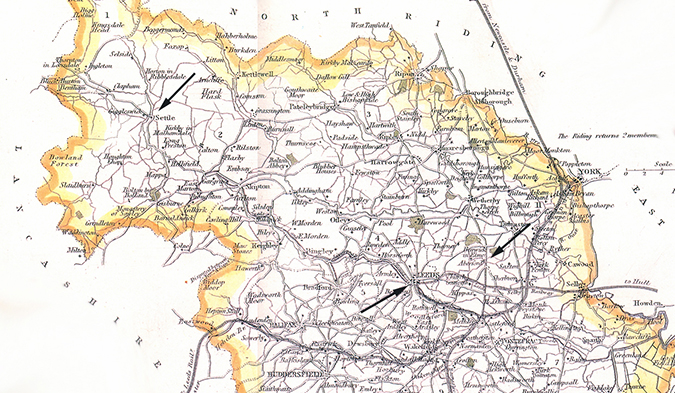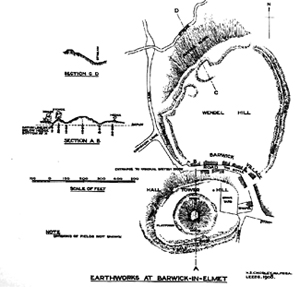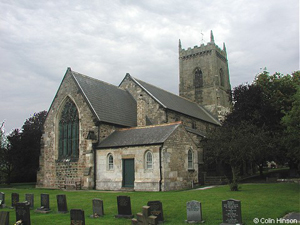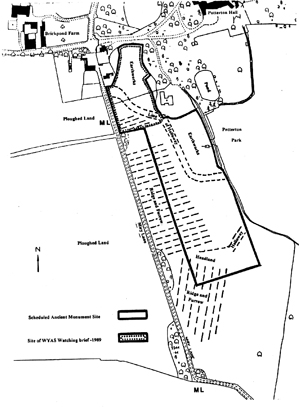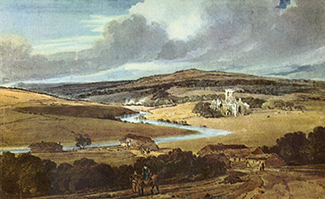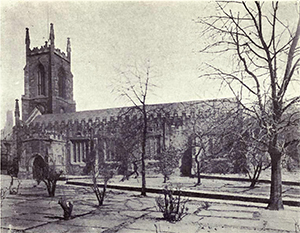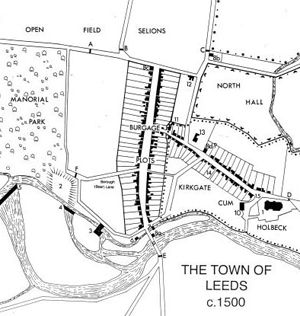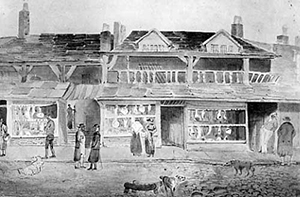The marriage of David C. Eidson (1838–1916) and Amanda E. Suttles (1840–1924) in Fulton County, Georgia, in 1861 brought together two families who had shared a similar journey for several centuries. Both families had roots in West Yorkshire that have been documented as early as the mid-sixteenth century but that, circumstantial evidence suggests, likely stretch much deeper in time. As emigrants to the New World in the mid-seventeenth and early eighteenth centuries, both families established themselves in what is now Richmond County on the Northern Neck of Virginia. Some of their children and grandchildren moved west and up the Potomac in Virginia in the early eighteenth century and, after the French and Indian War, down into the Carolina piedmont. Soon after the Revolution, both families were in northeast Georgia and, in the 1820s and 1830s, were among the earliest settlers of what became Fulton County in the western Georgia Piedmont. There, descendants still live in the early twenty-first century.
Prior to the sixteenth century, few of our ancestors left written records or even oral traditions, and reconstructing some sense of their history can seem impossible. And so it was for a very long time. In recent years, however, advances in genetic analysis have helped push the family horizon much further into the past, and continuing research in archaeology, anthropology, linguistics, and folklore have added even more to the story.
British physician and geneticist Stephen Oppenheimer has produced the most comprehensive synthesis of this disparate range of sources, and his characterization of the ancestry of the modern British informs understanding of anyone with ancestral roots in the British Isles. He found that three quarters of the ancestors of the modern British were hunter-gatherers who arrived between 15,000 and 7,500 years ago, before the melting ice caps had raised sea levels and created the British Isles. The Neolithic period brought a wave of farmers out of Anatolia, who over generations migrated through Italy, southern France and Spain, and then up the Atlantic seaboard to southern England, Cornwall, Wales, Scotland, and Ireland. And, Oppenheimer noted, "there were many later invasions, as well as less violent immigrations, and each left a genetic signal, but no individual event contributed much more than 5 per cent to our modern genetic mix."[1]
People have long been attached to places, of course, but DNA research has produced some startling demonstrations of that fact. One of the more spectacular examples is that of the famed "Cheddar Man," whose skeletal remains were discovered in a cave in southwest England in 1903. Genetic analysis in the early twenty-first century found that descendants of his mother were still residing within a few miles of the cave where he died some 9,000 years ago. Similarly, Alistair Moffat writes of genetic evidence suggesting that the descendants of Balkan miners who began working the ancient copper mines at Great Orme Head in northern Wales over four thousand years ago continue to live in the area today.[2]
When the Romans invaded Britannia in 47 BCE, they found several tribes, the largest of which was a loose confederation known as the Brigantes, who controlled most of what became northern England. By the time Rome withdrew from Britain in the late fourth and early fifth centuries, several small kingdoms had emerged from the shattered Brigantes. One of these was the Kingdom of Elmet, the ill-defined boundaries of which encompassed much of what is now West Yorkshire.
Germanic mercenaries had come with the Romans, but after about 350 CE, they were joined by Saxon settlers as well as Angles, Frisians, Jutes and other Germanic tribes who began crossing the North Sea to colonize what became known as England. Among them were probably the Eidson ancestors. The Angles were drawn to the areas around The Wash and the Humber River estauary on the island's east coast; and by 560, they controlled all of Yorkshire. The last of the native Brittonic kingdoms, Elmet, survived for a while as a client state but ceased to exist in 617 when it was absorbed into the Anglo-Saxon kingdom of Northumbria. The name lingers on in a few place names including the parish of Barwick-in-Elmet, where Suttles ancestors were born and buried.
In 793, the Anglo-Saxon Chronicle recorded the commencement of what is now known as the age of the Vikings:
This year came dreadful forewarnings over the land of the Northumbrians, terrifying the people most woefully: there were immense sheets of lightning rushing throuth the air, and whirlwinds, and fiery dragons flying across the firmament. These tremendous tokes were soon followed by a great famine; and not long after . . . the harrowing inroads of heathen men made lamentable havoc in the church of God in Holy Island by rapine and slaughter.[3]
The great monastery on the Holy Island of Lindisfarne had been founded in 634 by St. Aidan, the so-called "apostle of the English," and was the center for Christian evangelism in the north of England in the eighth and ninth centuries. Richly endowed, especially after its associations with St. Cuthbert (ca. 634–687), the island was where the magnificent Lindisfarne Gospels was created in the early eighth century. Its plundering by the Vikings sent shock waves through Christian Europe.
In 866, Danish Vikings captured what was left of the old Roman fortress town of Eboracum and established the Kingdom of Jórvík, part of the Danelaw that encompassed most of northern and eastern England. The kingdom was ruled by a series of Danish and Norwegian kings until the death of Eric Bloodax in 954.
The Norman Conquest in 1066 brought an end to the Danelaw but not to Anglo-Saxon resistance, and in 1069–1071, William the Conqueror launched a vicious campaign against rebels, the infamous "Harrying of the North." Much of northern England was laid waste so thoroughly that nine years of famine ensued. In his history of England, written within living memory of the event, Orderic Vitalis (1075–ca.1142) recorded the awful time:
His camps were scattered over a surface of one hundred miles; numbers of the insurgents fell beneath his vengeful sword, he levelled their places of shelter to the ground, wasted their lands, and burnt their dwellings with all they contained. Never did William commit so much cruelty; to his lasting disgrace, he yielded to his worst impulse, and set no bounds to his fury, condemning the innocent and the guilty to a common fate. In the fullness of his wrath he ordered the corn and cattle, with the implements of husbandry and every sort of provisions, to be collected in heaps and set on fire till the whole was consumed, and thus destroyed at once all that could serve for the support of life in the whole country lying beyond the Humber. There followed, consequently, so great a scarcity in England in the ensuing years, and severe famine involved the innocent and unarmed population in so much misery, that, in a Christian nation, more than a hundred thousand souls, of both sexes and all ages, perished of want.[4]
By the time it was over, three quarters of the population was dead or had fled, and the Anglo-Saxon aristocracy had been replaced by Normans. Among the survivors were at least some of the Eidson and Suttles ancestors, who would have been part of a slow rebuilding over the next two centuries. The great Cistercian abbey of Kirkstall, which was a landmark to later generations of Eidsons, was established in 1152 northwest of the de Lacy manor at “Loids,” modern-day Leeds, and a chapel, another landmark to the family, was built nearby at Allerton in the early thirteenth century. The ancient Anglo-Saxon church at Barwick-in-Elmet, burial place for Suttles ancestors, was also rebuilt in the late twelfth century.
The Black Death killed as much as half of the population of Europe between 1348 and 1350, wiping out entire villages and often forcing migration of any survivors. When the first of the documented Suttles and Eidson ancestors were being born a century later, Europe had only just readjusted to the economic and social turmoil precipitated by that disaster.
Suttles/Settle
Circumstantial evidence suggests that the Suttles surname, which was typically given as “Setle” or "Settle" in the early records of West Yorkshire, was probably derived from the small market town of Settle, located on the east bank of the River Ribble, forty-three miles northwest of Leeds and now on the southwestern border of Yorkshire Dales National Park. Nearby is the famous Victoria Cave, where a reindeer-antler harpoon tip some eleven thousand years old was discovered in 1837, the first evidence of human occupation in the dales.
Rarely was the spelling of surnames fixed since most people were illiterate and those that were literate would often spell surnames phonetically. So, in historical documentation for West Yorkshire in the sixteenth and seventeenth centuries record various spellings of the name, including Setle, Settle, Setthell, and Sedell. In the eighteenth century, in America, Settle, Setle, Settles, Suttle, and Suttles were all used by various branches of the family, with the latter being most common in nineteenth-century Georgia.
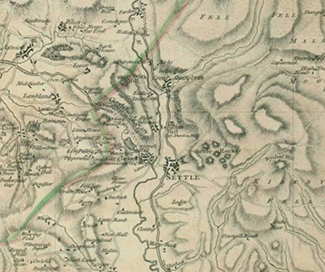
Figure 6. Settle and vicinity, from Jeffrey's map of Yorkshire, ca. 1770. |
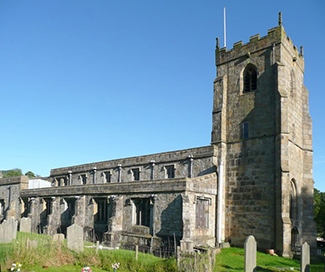
Figure 7. St. Alkelda's church at Giggleswick. (Wikipedia Commons) |
The Village of Settle
Settle had its origin in an Anglian settlement that developed around a convenient ford on the River Ribble in the seventh century CE. In the early ninth century, a church was dedicated to St. Alkelda at Giggleswick on the west side of the river, three quarters of a mile northwest of Settle's town center. It continued to serve the village until a church was built in Settle itself in the nineteenth century. The location of the early church suggests that the site may have had a holy well or other sacred site that pre-dated the village and Christianity.
The town was called "Setel" in the Domesday survey of 1086, and a village market was chartered in 1249. By the time the first bridge over the Ribble was mentioned in 1498, the Settle ancesters may have already left for Barwick-in-Elmet, forty-five or fifty miles to the southeast. Some of the family could have remained, since people tended to be rooted to place, but the social and economic turmoil left in the wake of the Black Death often forced relocation near and far.
Potterton, Barwick-in-Elmet
Barwick-in-Elmet is a small village some seven or eight miles east of Leeds. The site has been occupied by humans for thousands of years, and pre-Roman earthworks remain a prominent landmark in the area. The earthworks include the remains of a hill fort built in the seventh century BCE and is one of a very few prehistoric hill forts in northern England that has survived relatively intact. Other earthworks east of Barwick, including Becca Banks and the rest of the Aberford Intrenchments, are more or less contemporaneous.
By the sixteenth century, Potterton, across the Potterton Beck (a small watercourse) less than a mile northeast of the parish church, was the home of the Settle family. A place that always had an identity separate from Barwick-in-Elmet, “Potertun,” as it was listed in the Domesday Book, was a small village that was part of the medieval manor of Kippax, Ledston and Barwick.
In 1341, it was recorded that "Sir Robert de Nevill held the 'town of Podryngton' by the service of one knight's fee, there was a grange there and a messuage, with dovecote, that used to be the lord's capital messuage, the total rental being 13s.7d." By the time Colman published his History of Barwick-in-Elmet in 1908, there was little left of the medieval manor, and Potterton was the subject of several legends, among them that Bede's monastery was in the now-vanished Elmet wood and that the kings of Northumbria resided there, none of which is likely true. [5]
Today the most prominent landmark is Potterton Hall (ca. 1740), but to its south is a 217-acre protected archaeological zone that is the site of the medieval village of Potterton. No buildings survive, but the Barwick-in-Elmet Historical Society offers an evocative description of the remains, which include
earthworks incorporating a sunken holloway, terraced areas of dwelling platforms and ridge and furrow plough strips. . . . The holloway, which is the most well-defined feature of the earthworks, extends across the site from north west to south east, having a slight S shaped curve and an average depth of 3 feet. On the eastern flank of this are terraced areas considered to be the location of a small number of medieval dwellings. A platform near the field gate suggests the site of a larger house, and the places of other tenements, with their garths or enclosures, are defined with shallow ditches at either side of the holloway. [6]
The first appearance of the Settle surname in parish records is that of Robert Settle, one of twelve freemen named to the jury for the manorial court in 1548–49. The surname does not appear in the 1379 poll tax rolls or other medieval records for Barwick-in-Elmet, the parish in which Potterton was located. The earliest record of the name is that of Robert Settle, listed as one of twelve freemen named to the jury for the manorial court in 1548–49. He was probably the brother of John Settle (1499–1572) as well as of Henry, all of whom left probated wills in parish records.
John Settle married Elizabeth, whose maiden name is thought to have been Cooksey, around 1531, and they had seven children—Robert (1532–1585), Henry (1534–1587), William (1535–1573), Janet (1537–n.d.), Lawrence (1539–after 1572), Margaret (1540–n.d.), and Isabel (n.d.–after 1587). The sons, at least, grew to adulthood, married, had children, and died in Potterton or Barwick-in-Elmet. John Settle himself died in 1572 and his widow six years later; both are believed to be buried in now-unmarked graves in the churchyard at All Saints parish church in Barwick-in-Elmet. Their wills and those of several family members are recorded in the Exchequer and Prerogative Court of the Archbishop of York.[7]
John and Elizabeth’s second son, Henry (1534–1587), married a woman named Heline around 1568 and with her had at least four sons and two daughters—John II (1570–1623), Francis (1573–after 1587), Richard, (d. after 1587), and Mary (d. after 1587).
About 1621, Henry and Heline Settle's eldest son, John, is believed to have married a woman named Margery Francis (1588–1625). John was a glover and his will in 1622 is generally thought to connect the Settles of Barwick-in-Elmet with Francis Settle who emigrated to Virginia. In that will, John Settle writes of a "son or daughter not yet bourne," and many believe that the child which was born not long after his father’s death was Francis “Posthumous” Settle (1623–1707).
Young Francis Settle had the misfortune of coming of age in the midst of the English civil wars that raged between 1738 and 1752, pitting a Puritan parliament against Royalists in support of King Charles I. The northern counties were strongly royalist, but in July 1744 Royalist forces were decisively defeated at Marston Moor, thirteen or so miles northeast of Barwick-in-Elmet, leaving Parliament in control. As many as 250,000 people died during the wars, which dragged on to the 1750s, even after the king was beheaded in January 1749 and the Puritan commonwealth established. Among those who refused to submit was the Royalist stronghold at Pontefract, eleven or twelve miles south of Barwick; but, after a long seige, the castle was surrendered and demolished in the summer of 1749.
How much, if at all, Francis Settle was a part of the civil war is not known, but as an unmarried man in his twenties through most of the conflict, his participation in battles is not at all unlikely. And circumstantial evidence suggests that the Settles were not part of the puritan revolution. Royalist forces were defeated at Worcester in September 1651, the last battle of the civil wars, but an uprising in March 1655 resulted in the establishment of a military dictatorship dominated by Oliver Cromwell. Persecution of those who resisted the puritan revolution was severe, and in November 1655 the old Anglican liturgy was outlawed, replaced by state Presbyterianism.
As a result of all of the turmoil, many royalist sympathizers left the country, many to Virginia, where the population tripled between 1645 and 1665. Among them were wealthy "distressed cavaliers," who although relatively small in number put an indelible stamp on the colony's politics and culture. Along with them came tenants and indentured servants, who accounted for perhaps 75% of all emigrants to the colony. According to one historian of the period, they came from "the bottom of the middle ranks, below their older and wealthier contemporaries, but above the poor laborers, vagrants, and the destitute." Among them was Francis Settle, who emigrated to Virginia in 1656. [8]
Eidson
The origin of the surname "Eidson" is uncertain, but the original meaning may have related to the River Eider in the German state of Schleswig-Holstein, a river that served as a sort of boundary between the Danes, the Angles, and the Saxons. As with most surnames, spelling is erratic in early documention and often makes sense only in terms of phonetics, Eitson, Edson, Hitson, and Itson being among the more common variations.
Leeds
The Eidson ancestors are first documented in the vicinity of Leeds in the sixteenth century. Located on the Aire River seven or eight miles west of Barwick-in-Elmet, the town evolved out of a Roman outpost at a good ford in the river. “Loidis” was first mentioned by the Venerable Bede in the early eighth century, but in Saxon times, the town, according to one opinionated source writing in the nineteenth century,
consisted of three wretched lanes, the humblest and meanest possible representations of streets, with a population of two or three hundred semi-barbarians, the rude cultivators of the soil upon which they vegetated, with seven Thanes to hold them in the trammels of dependence, with a priest to rivet the fetters of superstition, and a church in which to behold the unintelligible mummeries which in those days of darkness were dignified with the prostituted name of Christianity.[9]
In 1086, the Domesday Book recorded that Leeds had “ a priest, a church, a mill and 10 acres of meadow, 27 labourers, 4 freemen, 4 cottagers.”[10] Among them could have been some of the Eidson ancestors.
In 1207, the Lord of the Manor of Leeds granted a charter for a “new town” that was built along a street running north from the river crossing. By the end of the fourteenth century, a stone bridge had been constructed and the street was known as Briggate, the genesis of the modern city center of Leeds.
Leeds grew into a prosperous market town in the Middle Ages and was an established center of the linen industry by the middle of the thirteenth century. Yorkshire, presumably including Leeds, was decimated in 1349 when the Black Plague first appeared and killed a third of the population, but the town ultimately survived and prospered. In 1533, around the time the Eidsons first appear in parish records, it was described as having “a praty market” as well as “paroche churche reasonably well buildid.” It was, the author commented, “as large as Bradford, but not so quik as it.”[11]
Weetwoodside
The earliest Eidson ancestors who have been identified are Ralph Eidson (1537–1590) and his wife Genet (1539–1603/04), who both may have had long roots around Chapel Allerton, two miles northeast of the center of Leeds. The chapel, which was established by 1240, would have been a landmark for the Eidson ancestors until its demolition in the eighteenth century. It had been associated with the Cistercian abbey of Kirkstall, the monastery established in the twelfth century and ruined after its surrender to the Crown in 1539. After their marriage they appear to have lived in Weetwoodside, two or three miles west of Chapel Allerton and three or four miles northwest of Leeds.
Four children of Ralph and Genet Eidson have been documented, all apparently born in Weetwoodside: William, born in 1563; Isabella, born in 1570; Dionis, which was probably a variant of “Dennis,” born in March 1574/75; and Janet, born in 1582. Quite likely there were others. [12]
Around 1600, Dionis Eidson married Isabel Boyes, born 9 June 1582 to Christopher Boyes (c. 1530–1606) and his wife Grace, both of whom were also born and lived their lives around Chapel Allerton just north of Leeds. Like Eidson, the surname was variable in its spelling, with Boyes and Boyce found in seventeenth-century Leeds, with the latter variation being carried on as the given name of several of their Eidson descendants in America. Five children have been documented from their marriage: a son, Edward, baptized 6 April 1603, and four daughters, Ann, Gennett, Elizabeth, and Grace. Dionis Eidson died on 24 August 1629; his will was proven on 13 November, naming his wife Isabel Boyes.[13]
In the early 1620s, Edward Eidson married Elizabeth Smith, born in 1606 at Harwood in Lancashire. Four children have been documented, all born in Leeds: Frances, born 1624; Elizabeth, born 1630; William, born 1632; and Dennys, born 1635. Disease or other misfortune carried off Edward Eidson on New Years Day 1636 and his wife followed two years later; both were buried at the Beckett Street Cemetery in Leeds. They left at least four orphaned children, the youngest barely three years old. The dreadful infant mortality rates and an adult life expectancy of perhaps 35 took a toll on most families. Plague remained endemic throughout the seventeenth century, with over thirteen hundred people, a fifth of the population of Leeds, dying of the disease in 1644-45 and hundreds more in the awful plague year of 1665.
There is no documentation for who raised Edward and Elizabeth Eidson’s orphans, but presumably they grew to adulthood in or around Leeds. On 12 September 1660, Dennys Eidson married Hannah Boyce, daughter of Matthew Boyce (1611–1679) and Elizabeth Jackson (1616–1675). The elder Boyces were among the twenty families who left the port of Hull on the ship John of London, bound for the Massachusetts Bay Colony in the summer of 1638. Led by the Reverend Ezekiel Rogers, they settled northwest of Salem in 1639, naming their town Rowley after the village near Hull where Rogers had preached for twenty years until being expelled for “nonconformist puritanical” beliefs. Matthew and Elizabeth Boyce’s first child, Samuel, was born in 1640, followed by Hannah on 16 May 1642, Elizabeth in 1646, and Mercy in 1650. By the time their last child, Joseph, was born in 1658, Matthew and Elizabeth Boyce and, presumably, their children had returned to Leeds. Both parents died there in the late 1670s. Why they returned to England has not been documented.
Dennys and Hannah Boyce Eidson’s first child, Elizabeth, was born in December 1661 and the birth of four more children—Matthew, born in 1663, and named for his maternal grandfather; Hannah, born in 1664; Mary, born in 1666; and John, born in 1670—have been documented in Leeds. As always there were probably other children who died at an early age—the plague killed large numbers of people in Leeds in 1665, Their last known child was born in October 1680 and named Edward in honor of his paternal grandfather. For reasons that have not been explained, he was born in Dublin, Ireland, where he was christened at St. Catherine’s Church on 17 October 1680. Hannah Eidson’s younger brother Joseph Boyce (1658–1728) gained some renown as the minister of the Presbyterian church on Wood Street in Dublin, and that may have had some connection with the family’s relocation to Dublin. The last record of Edward Eidson in Leeds is in 1683 when he was dropped from the parish records. At the same time, there is no further record of any Eidsons in Ireland beyond Edward’s christening in 1680.
Why Edward Eidson was dropped from the parish roles has not been documented. The most obvious answer is that the family remained in Dublin, but that is not certain. Or did it mean that he and perhaps his family had become Dissenters, perhaps joining his mother’s brother’s Presbyterian congregation in Dublin? Surely, he would have grown up with tales from his mother’s family about Puritan New England. All that is known, or surmised, is that he emigrated, perhaps as a teenager, and arrived in Virginia between 1696 and 1705. Why he would have gone to Virginia, which had little use for Dissenters during that period, is not known and is perhaps an indication that his parents’ religious inclinations were not his own.
![]()
Notes
1. Quoted in Stephen Oppenheimer, “Myths of British Ancestry,” Prospect Magazine, Issue 127, October 2006, accessed online at <http://www.prospectmagazine.co.uk/features /mythsofbritishancestry>, 18 January 2015, summarizing some of his findings published in his book The Origins of the British (London: Constable & Robinson Ltd., 2007).
2. Alistair Moffat, The British: A Genetic Journey (Edinburgh: Birlinn Ltd., 2013), p. 103.
3. Quoted in Alistair Moffat, To the Island of Tides: A Journey to Lindisfarne (Edinburgh: Canongate Publishing, 2019), p. 161.
4. Orderic Vitalis, The Ecclesiastical history of England and Normandy, Vol. II, p. 28, facsimile copy accessed online at <https://archive.org/details/ ecclesiasticalhi03orde>,” 3 September 2012.
5. F. S. Colman, A History of the Parish of Barwick in Elmet in the County of York (Leeds, UK: The Thoresby Society), p. 231.
6. Arthur Bantoft and Tony Cox, "The History Of Potterton: Part 1, The Early Years—Agriculture and Industrty," The Barwicker, No. 36 (December 1994), accessed online at <http://www.barwickinelmethistoricalsociety.com>, 17 April 2020.
7. George Denison Lumb, Wills, Registers, and Monumental Inscriptsions of the Parish of Barwick-in-Elmet, Co. York (Leeds: Privately printed by subscription, 1908). His will is at pp. 20-21; her will is at pp. 24-25.
8. David Hackett Fischer and James C. Kelly, Bound Away, Virginia and the Westward Movement (Charlottesville VA: University of Virginia Press, 2000), pp. 43–4.
9. Edward Parsons, The tourist's companion; or, The history of the scenes and places on the route by the railroad and steam-packet from Leeds and Selby to Hull (London, 1835), p. 2.
10. See "Briggate," at Discovering Leeds, accessed online at <http://www.leodis.net/discovery>, 22 April 2020.
11. Quoted in Parsons, The Tourist's Companion..., p. 96.
12. Thoresby Society, Vol 1, Part 1, Leeds Parish Church Records 1571-1588 (Leeds 1889). The society has published all of the extant parish registers.
13. Material not otherwise sourced in this essay has been drawn from “The Descendants of Edward Eidson,” by the late George Eidson of Shepherd, MT. (Accessed through George Eidson CD, version June 2007, in possession of the present author).
![]()
Sources
Bantoft, Arthur, and Tony Cox, "The History Of Potterton: Part 1, The Early Years—Agriculture and Industrty," The Barwicker, No. 36 (December 1994).
Colman, F. S. A History of the Parish of Barwick in Elmet in the County of York. Leeds, UK: The Thoresby Society, 1908.
Fischer, David Hackett, and James C. Kelly. Bound Away, Virginia and the Westward Movement. Charlottesville VA: University of Virginia Press, 2000.
Lumb, George Denison. Wills, Registers, and Monumental Inscriptsions of the Parish of Barwick-in-Elmet, Co. York. Leeds: Privately printed by subscription, 1908; facsimile reproduction by Bibliolife, Charleston SC, n.d.
Moffat, Alistair. The British: A Genetic Journey. Edinburgh: Birlinn Ltd., 2013.
–––. To the Island of Tides: A Journey to Lindisfarne. Edinburgh: Canongate Publishing, 2019.
Oppenheimer, Stephen. The Origins of the British. London: Constable & Robinson Ltd., 2007.
Parsons, Edward. The tourist's companion; or, The history of the scenes and places on the route by the railroad and steam-packet from Leeds and Selby to Hull. London, 1835.
Thoresby Society, Vol 1, Part 1, Leeds Parish Church Records 1571-1588. Leeds, 1889.
Various un-named authors. A History of the Town and Parish of Leeds: Compiled from Various Authors. To which are Added, a History of Kirkstall Abbey. And a Leeds Directory. Leeds 1797.
Vitalis, Orderic. The Ecclesiastical history of England and Normandy, Vol. II. Accessed online at <https://archive.org/details/ecclesiasticalhi03orde>,” 3 September 2012.
![]()
